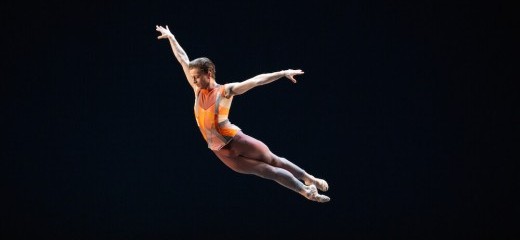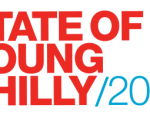
Of Stravinsky and Men
by Mira Treatman
The music of Igor Stravinsky single handedly moved ballet from its high classical to neoclassical periods. Nearly fifty years after his death, the Pennsylvania Ballet and orchestra performed their All Stravinsky Program, which included the composer’s works written in his prolific neoclassical period: George Balanchine’s Apollo (1928) and Stravinsky Violin Concerto (1972), Matthew Neenan’s Deco (2019), and Jerome Robbins’ The Cage (1951). The three choreographers’ interpretations of the bombastic, rhythmically complex works represented magnificent developments in generational views on masculinity in ballet.
The curtain rose on Sterling Baca in the title role of Balanchine’s Apollo. He started his first solo dressed in white, strumming a decidedly phallic-looking lyre. His three muses – Lillian DiPiazza as Terpsichore, Mayara Pineiro as Polyhymnia, and Alexandra Hughes as Calliope – bowed to the young god in reverence, before dancing short gestural variations conveying their musedom. Despite the established hierarchy between the god and the muses situated below him in status, the three senior women of the company commanded the ballet with authoritative mastery of the quick, stylistic footwork.
Apollo was well cast. DiPiazza had excellent chemistry with Baca, with whom she danced the central pas de deux. Pineiro’s role showed off her speed and precision in the demanding pirouette turns. Calliope was a vehicle for Hughes’s lucidity of footwork and ease of occupying her own stage space. All three women were credible interpreters of the classic, living up to the familiar Balanchine mantra, “ballet is woman.”
In watching Apollo in 2019, recent events surrounding some of its most famous interpreters came to mind. Peter Martins, former ballet-master-in-chief of the New York City Ballet, was an iconic interpreter of the role circa the 1960-70s. In 2018 after a brief investigation, Martins stepped down from the position he held since 1983 in response to yet-to-be-corroborated accusations of physical and psychological abuse in the workplace. A year later, one of the most beloved Apollo interpreters of the 21st century and a generational peer of Baca’s, Chase Finlay, resigned from the same company after his involvement in a sexual misconduct and abuse case.
Despite the unavoidable association between Martins and Finlay with Apollo, Baca refreshingly made this debut all his own. Baca reinserted some of the morality and honor into the role of the young god that, perhaps, this ballet has missed in recent years. Consistent with his performance in other classical works, Baca never lost the Adonis edge or noble quality in his dancing, which were particularly right for this role.
Where Apollo left off in tracking the story of a young god coming into his own, Jerome Robbins picked up with a similar narrative in The Cage—a young female creature being initiated into a matriarchy. The queen, Dayesi Torriente, taught the novice, Oksana Maslova, how to behave within the sorority and with the intruding men who approached her. As part of the choreography, Maslova, one of the most physically gifted in the company, extinguished both male intruders in fierce duets. The result of the woman as victor was in harmony with the ways of the world established by Torriente. In comparing Robbins to Balanchine, one could say that this jump from patriarchy to matriarchy was a step in a more just direction, but both were equally violent with stratified power structures and, in the case of Robbins, literally killing.
For better or worse, Martins was also a figure deeply connected with Stravinsky Violin Concerto, as the originating dancer in the “Second Aria.” This section featured a mysterious, sensual pas de deux for the shorter woman and taller man of the four principal dancers. Arian Molina Soca, in the Martins role, partnered Nayara Lopes, in the role originated by Kay Mazzo, with soft yet chivalric determination. The revelations of ballet’s #MeToo moment has altered the way the pas de deux reads. What once could have been called creative or boundary-breaking intimacy in partnering appeared now like manhandling and manipulation. Yes, this ballet circa the behemoth 1972 Stravinsky Festival was a product of its time, but emotionally-driven, contemporary readings of the work in response to current events are equally valid.
Jumping from Balanchine to Matthew Neenan, increasingly one of the defining voices of his generation, presented a study in the evolution of masculinity. Deco, choreographed to Stravinsky’s Piano Sonata and Tango, featured an ensemble that demonstrated a mastery of Neenanisms—jagged walking with straight legs and hyperextended knees, flaccid hands in conversation-like pedestrian romps, fleeting moments of theater, chins sticking out while dancers traveled, and a healthy amount of flirtatious hands on hips.
Deco, like Apollo, opened with a solo for a man, but it couldn’t be farther removed from the princely uber-masculinity of early Balanchine. Albert Gordon, in a follow-up solo to his breakout in Neenan’s It Goes That Way, was one of Neenan’s finest interpreters of the choreographer's idiom. Much of Neenan's movement material, with its enigmatic softness and stretchy extensions of the leg, was historically more likely given to a woman. For a choreographer known for illuminating the music of queer icon Rufus Wainwright, it was no surprise that Neenan’s material for Gordon embodied jaded Gen-X coolness right alongside a certain gender-fluid performance affect very much of the now.
Neenan joined the cast for the premiere’s bows, and took a place right next to Gordon. The two physically resemble one another, particularly in their hyperextended knees and proud, kind body language. Like Balanchine and Martins, they bowed together as choreographer and muse but undoubtedly without the violence.
All Stravinsky Program, Pennsylvania Ballet, The Merriam Theatre, April 4 - 7.
By Mira Treatman
April 15, 2019








